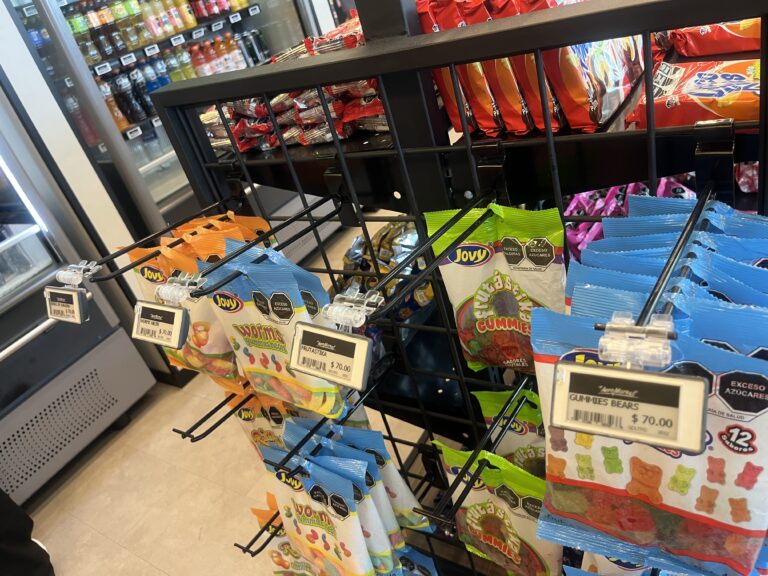Introduction
Retailers face a constant challenge: keeping pricing accurate and competitive without wasting time or resources. Traditional paper tags demand frequent manual changes, leading to pricing errors and frustrated customers.
That’s where Electronic Shelf Labels (ESLs) come in. These digital price tags allow businesses to update pricing instantly, ensuring consistency across all locations. With ESL systems, stores can implement real-time discounts, synchronize with online pricing, and streamline operations—all without requiring employees to change labels manually.
But how do these systems work, and why are so many retail chains making the switch? This guide dives into the benefits, technology, and future of ESLs, showing how they help businesses stay ahead in an increasingly competitive market.
1. The Evolution of Retail Pricing: From Paper Tags to Digital Displays
Let’s take a trip down memory lane.
Before the rise of digital technology, price adjustments in stores were a tedious and error-prone process. Employees had to manually replace paper labels, leading to inconsistencies, pricing disputes, and lost sales.
Fast forward to today, and retailers are embracing smart pricing solutions to streamline operations. The shift from traditional price tags to automated digital displays has completely transformed how businesses manage pricing strategies.
So, how did we get here? Let’s break it down.
1.1 The Era of Manual Price Tags
Not so long ago, paper tags ruled the retail world.
Every time a store needed to adjust a price—whether for a discount, a new product launch, or an inflation-related update—employees had to print, cut, and attach new labels manually.
This outdated system came with serious downsides:
- High labor costs – Workers spent hours replacing labels instead of focusing on customer service.
- Frequent human errors – Pricing mismatches between shelves and checkout systems frustrated shoppers.
- Inconsistent updates – Large retailers with multiple locations struggled to keep prices aligned.
As consumer expectations for seamless shopping experiences grew, it became clear that a more efficient pricing method was necessary.
1.2 Introduction of Digital Price Displays
Then came the game-changer.
Advancements in technology paved the way for automated price updates using digital displays. Retailers started exploring electronic pricing solutions, which eliminated the need for manual changes.
These solutions not only reduced labor costs but also improved pricing accuracy, creating a more transparent shopping environment.
1.3 Why Businesses Are Switching to Digital Labels
Why are so many businesses making the leap?
It’s simple—efficiency, accuracy, and cost savings.
Retailers that have adopted modern pricing solutions have seen:
✅ Faster price changes – Updates happen instantly across all locations.
✅ Fewer pricing disputes – Customers trust that the displayed price is correct.
✅ Better inventory management – Data synchronization allows retailers to track sales trends effectively.
With these advantages, it’s no surprise that retailers are ditching paper labels and moving towards a smarter, more responsive pricing system.
2. What Are ESL Systems and How Do They Work?
Now that we understand the shift from traditional tags to automated pricing, let’s dive into the mechanics behind these modern solutions.
At the heart of this transformation lies Electronic Shelf Label (ESL) systems—a technology that enables retailers to manage pricing remotely and in real-time.
But how do these systems function?
Let’s break it down step by step.
2.1 Components of an Automated Pricing System
An ESL system consists of three key elements:
1️⃣ Digital Price Tags – Small, screen-based labels that display pricing and product details.
2️⃣ Centralized Software – A cloud-based or on-premise system that controls pricing updates.
3️⃣ Wireless Connectivity – A network (Wi-Fi, NFC, or Bluetooth) that syncs the price data.
Together, these elements ensure that every store shelf reflects the correct price—without employees having to lift a finger.
2.2 Wireless Communication and Data Syncing
How do updates reach every price tag so quickly?
Through wireless data transmission, stores can instantly modify pricing based on demand, promotions, or competitor activity.
Most modern systems use:
- Wi-Fi networks – Fast and reliable for large-scale operations.
- Near Field Communication (NFC) – Enables quick updates in smaller retail spaces.
- Bluetooth Low Energy (BLE) – A cost-effective way to keep labels connected.
With this level of automation, price updates happen in real time, ensuring seamless pricing consistency across all channels.
2.3 Real-Time Pricing Across All Locations
Imagine running a nationwide retail chain and needing to update product prices across hundreds of stores.
Without automated pricing, it could take days or even weeks to make sure every location has the correct information.
But with an ESL system?
✅ Instant updates across all stores
✅ No risk of human error
✅ Seamless synchronization with online prices
This ability to adapt pricing on the fly is what makes automated pricing solutions an essential tool for modern retailers.
3. The Benefits of Digital Pricing for Retailers
Now that we’ve covered how these systems work, let’s talk about why businesses love them.
Retailers today are under pressure to operate more efficiently, reduce costs, and enhance customer experiences. That’s where smart pricing solutions play a major role.
Here’s how they’re changing the game.
3.1 Instant Price Adjustments Without Hassle
Gone are the days of manually replacing price tags.
With real-time price updates, businesses can instantly reflect changes for promotions, markdowns, and even competitor-based adjustments.
Benefits include:
✅ No delays – Promotions go live the second they’re scheduled.
✅ Higher sales conversion – Customers respond better to accurate and timely discounts.
✅ Fewer errors – No more mismatches between shelf tags and checkout prices.
3.2 Cost Savings on Labor and Operations
Think about how much time employees spend printing, cutting, and attaching paper labels.
Now imagine eliminating that task entirely.
By automating the process, businesses:
💰 Reduce labor costs – Employees can focus on customer service instead of price updates.
🛠 Minimize operational inefficiencies – Less room for pricing mistakes that lead to customer complaints.
📊 Optimize store management – Store managers can focus on improving sales strategies rather than fixing price tag issues.
3.3 A Better Shopping Experience for Customers
Customers expect transparency and accuracy when they shop.
If a price on the shelf doesn’t match the price at checkout, it leads to frustration—and potentially lost sales.
With digital pricing solutions, businesses can:
✅ Ensure consistent pricing across all locations
✅ Eliminate confusion at checkout
✅ Boost customer trust and loyalty
By providing accurate, real-time information, retailers can create a seamless, hassle-free shopping experience that keeps customers coming back.
With the power of automation, retailers are gaining a competitive edge in today’s fast-paced market.
But that’s just the beginning.
Up next, we’ll explore how smart pricing strategies can help businesses optimize inventory, track sales trends, and integrate seamlessly with online channels. 🚀
4. How ESLs Help Retailers Stay Competitive
Retail is evolving fast.
With the rise of online shopping and dynamic pricing strategies, traditional pricing methods simply can’t keep up. Retailers need to react quickly to market trends, customer demand, and competitor prices.
That’s where smart pricing solutions come into play. These systems allow businesses to adjust price tags in real time, helping them stay ahead in an increasingly competitive market.
So, how exactly do they give businesses an edge? Let’s break it down.
4.1 Dynamic Pricing for Real-Time Adjustments
Pricing isn’t static anymore.
Retailers today use data-driven insights to modify pricing based on:
✔ Demand fluctuations – Adjust prices for popular items during peak hours.
✔ Competitor pricing – Stay competitive by matching or beating rival stores.
✔ Stock levels – Discount slow-moving products to optimize inventory.
With automated price adjustments, businesses can react instantly to sales trends—ensuring they maximize revenue while keeping customers happy.
4.2 Smarter Inventory Management
Overstock and stockouts are a retailer’s worst nightmare.
By integrating digital pricing tools with inventory systems, stores can:
✅ Track real-time product movement – Know exactly which items are selling.
✅ Trigger markdowns automatically – Clear slow-moving stock efficiently.
✅ Reduce waste – Especially important for food retailers managing perishable goods.
This level of inventory control leads to better decision-making and improved profitability.
4.3 Omnichannel Price Synchronization
Shoppers expect consistent pricing across all sales channels.
With automated pricing solutions, businesses can:
✔ Ensure price consistency between in-store and online platforms.
✔ Offer seamless customer experiences across multiple locations.
✔ Implement promotional pricing instantly without delays.
By maintaining price accuracy across digital and physical storefronts, businesses build trust and encourage repeat customers.
5. Implementing an ESL System: What Retailers Need to Know
Thinking about making the switch?
While automated pricing technology offers undeniable benefits, proper implementation is key. Retailers need to consider several factors before rolling out a full-scale upgrade.
Here’s what businesses should focus on.
5.1 Choosing the Right Digital Pricing System
Not all solutions are created equal.
Before selecting a provider, businesses should evaluate:
✅ Display quality – Is the information clear and easy to read?
✅ Battery life – Does it last long enough to minimize maintenance?
✅ Connectivity options – Wi-Fi, Bluetooth, or NFC? Which suits your store best?
Top providers include Pricer, Hanshow, and Ses-Imagotag, among others, each offering unique features to suit different retail needs.
5.2 Seamless Integration with Store Systems
For a smooth transition, automated pricing solutions must sync with:
✔ Point of Sale (POS) software – Ensures checkout prices match shelf displays.
✔ Enterprise Resource Planning (ERP) systems – Helps track product performance.
✔ Promotional tools – Allows real-time discounts and loyalty program integration.
Choosing a solution that integrates easily with existing infrastructure prevents disruptions and maximizes efficiency.
5.3 Cost vs. ROI: Is It Worth It?
The upfront investment may seem significant, but the long-term savings are undeniable.
Retailers experience:
✅ Lower labor costs – No more manual label replacements.
✅ Fewer pricing errors – Reduces lost revenue from mispriced items.
✅ Higher sales conversions – Timely promotions increase customer purchases.
By calculating the return on investment (ROI), businesses can make informed decisions about adopting digital pricing strategies.
6. Overcoming Challenges in ESL Adoption
No system is perfect.
While smart pricing solutions offer undeniable advantages, retailers must address potential obstacles before full implementation.
Let’s look at the key challenges and how to tackle them.
6.1 Ensuring Reliable Network Connectivity
A pricing system is only as good as its connection.
Retailers need to ensure:
✔ Stable Wi-Fi or Bluetooth – Prevents delays in price updates.
✔ Backup systems – Avoids disruptions in case of network failures.
✔ Cybersecurity measures – Protects against unauthorized price changes.
A strong, secure infrastructure guarantees smooth operations and protects business data.
6.2 Employee Training for a Smooth Transition
Technology is only effective if staff know how to use it.
To avoid confusion, retailers should:
✅ Conduct hands-on training sessions – Teach employees how to manage digital pricing.
✅ Create easy-to-follow guides – Provide step-by-step instructions for troubleshooting.
✅ Appoint in-store tech experts – Ensure someone is available to handle issues as they arise.
A well-trained workforce ensures the transition is seamless and efficient.
6.3 Compliance with Pricing Regulations
Every region has different rules regarding price display transparency.
To stay compliant, businesses should:
✔ Double-check automated updates – Ensure legal accuracy in displayed pricing.
✔ Implement customer price-check stations – Allows shoppers to verify costs.
✔ Keep a digital record of price changes – Useful for audits and regulatory checks.
By following these best practices, retailers can avoid legal complications and maintain consumer trust.
Up next, we’ll explore what the future holds for retail pricing—from AI-powered pricing strategies to sustainable retail solutions that reduce waste. 🚀



